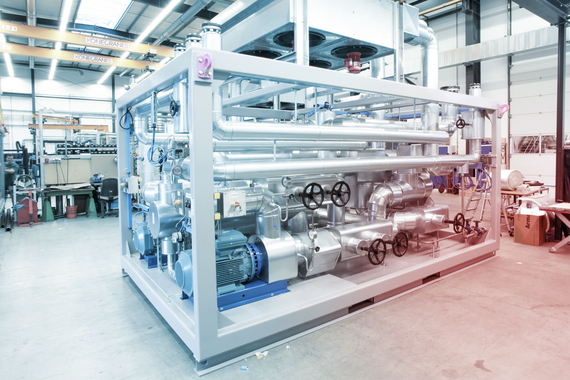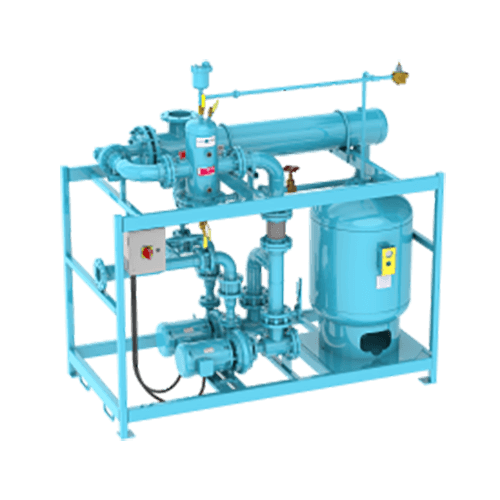What Makes DVS Heat Transfer Systems Ideal for Aerospace Thermal Solutions?
The Function of Heat Transfer Equipments in Sustainable Power Solutions for the Future
Heat transfer systems are crucial in the pursuit for lasting power services. They maximize thermal energy administration, boosting the efficiency of renewable innovations. By utilizing mechanisms like conduction, convection, and radiation, these systems minimize power losses. Their role in solar thermal and geothermal applications is especially considerable. As innovations arise, the potential for further innovations increases crucial concerns about future power techniques. What growths will form the landscape of lasting energy?
Understanding Heat Transfer Systems

The Value of Thermal Power Management
Efficient thermal power management is important for making best use of energy effectiveness and decreasing waste in various systems. By managing temperature level and maximizing Heat transfer procedures, companies can substantially reduce power usage and operational costs. Reliable management involves the implementation of innovative technologies and techniques that check and control thermal problems within systems, making sure that power sources are made use of effectively. Furthermore, appropriate thermal energy management adds to decreasing greenhouse gas discharges, straightening with worldwide sustainability objectives. It likewise improves system reliability and performance, causing boosted item top quality and longer equipment life-span. Eventually, focusing on thermal energy monitoring is an important action in the direction of producing much more lasting energy options and promoting a liable method to energy usage in domestic and industrial contexts.
Applications of Heat Transfer in Renewable Resource
While various renewable resource sources guarantee sustainability, the reliable application of Heat transfer plays an essential duty in their performance. In wind power systems, Heat transfer is used for turbine element cooling, improving performance and long life. Geothermal power counts on effective Heat exchange between the planet's subsurface and the fluid circulating in the system, optimizing power extraction. Biomass energy processes additionally take advantage of Heat transfer, as it helps in transforming natural materials into functional fuel via pyrolysis and gasification. In addition, in hydropower, maintaining excellent temperature levels in reservoirs can improve energy output. Each of these applications shows the essential importance of Heat transfer systems in boosting eco-friendly energy innovations, ultimately adding to a much more lasting energy future.
Enhancing Solar Thermal Power Performance
As solar thermal power systems remain to progress, improving their effectiveness has actually ended up being vital for maximizing energy output. Developments in Heat transfer modern technologies, such as boosted thermal storage space products and ingenious Heat exchangers, play a considerable role in improving performance. By making use of advanced products that have superior thermal conductivity, systems can move and record Heat much more efficiently. In addition, integrating radar that adhere to the sunlight's path guarantees that enthusiasts get excellent solar direct exposure throughout the day. Making use of nanotechnology in solar absorbers can better boost power absorption prices. Incorporating automated control systems aids regulate temperature levels and take care of power distribution efficiently, leading to minimized losses and enhanced total system effectiveness. These enhancements lead the way for more lasting solar thermal power options in the future.
Geothermal Heating: A Lasting Remedy
Geothermal heating provides a feasible choice for lasting energy, supplying considerable ecological advantages through minimized greenhouse gas discharges. Its performance and cost-effectiveness make it an appealing choice to standard home heating systems. Nevertheless, obstacles associated with execution should be dealt with to maximize its potential effect.
Environmental Advantages of Geothermal
Typical heating approaches contribute considerably to greenhouse gas discharges, geothermal heating offers an engaging choice that reduces ecological impact. By taking advantage of the Planet's interior Heat, geothermal systems utilize a sustainable power source, noticeably decreasing reliance on fossil fuels. This technique generates marginal carbon discharges, making it a cleaner choice for business and property home heating. In addition, geothermal systems advertise power efficiency, as they call for less energy contrasted to conventional heating systems. DVS Heat Transfer Systems. The usage of geothermal energy additionally aids in decreasing air pollution, boosting local air top quality and public health. As a lasting solution, geothermal heating supports environment adjustment mitigation efforts, placing itself as an important element in the change towards a greener future
Efficiency and Cost-Effectiveness
Exactly how does geothermal heating gauge up in regards to performance and cost-effectiveness contrasted to traditional heater? Geothermal home heating shows exceptional efficiency, usually accomplishing a coefficient of efficiency (COP) of 3 to 5, indicating it generates 3 to 5 units of Heat for each unit of electrical energy eaten. This efficiency converts into lower operating expense, especially in areas with stable geothermal resources. First setup prices can be greater than standard systems; nevertheless, lasting cost savings on energy costs and lowered upkeep expenses can counter these upfront financial investments. Furthermore, several navigate to this website governments incentivize geothermal systems via rebates and tax obligation credit histories, enhancing their cost-effectiveness. Overall, geothermal home heating becomes a lasting and financially practical choice to more standard heating remedies.
Execution Obstacles and Solutions
Countless obstacles can hamper the extensive execution of geothermal heater, regardless of their clear advantages as a lasting energy solution. High initial installment prices usually hinder financiers and house owners, making financing a considerable barrier. In addition, the geographical constraints of suitable geothermal websites limit ease of access in certain areas. Neighborhood laws and permitting procedures can also make complex project advancement, bring about delays. Public awareness and understanding of geothermal systems continue to be low, impeding acceptance. To deal with these difficulties, targeted education and learning campaigns can enhance open secret, while government incentives can minimize monetary concerns. Working together with local authorities to streamline regulations this hyperlink might assist in smoother job approvals, ultimately promoting the adoption of geothermal home heating as a sensible, sustainable energy choice.
Developments in Heat Transfer Technologies
Innovations in Heat transfer innovations play an essential function in enhancing energy effectiveness and sustainability. Advanced Heat exchangers and stage change products go to the center of these advancements, providing considerable enhancements in thermal administration. These innovations not just maximize energy usage yet likewise contribute to minimizing environmental impact in various applications.
Advanced Heat Exchangers
Advanced Heat exchangers play a crucial function in boosting power performance across different applications in sustainable power services. These tools facilitate the transfer of Heat between two or more fluids, significantly lowering power usage in procedures such as commercial heating, air conditioning, and power generation. Technologies in products and style, such as using nanofluids and small arrangements, have led to boosted thermal performance and decreased dimension needs. Furthermore, innovations in digital surveillance and control systems allow for enhanced operation, more boosting effectiveness. By decreasing waste Heat and making the most of energy recovery, progressed Heat exchangers contribute to reduce carbon footprints and support the shift towards eco friendly innovations. Their continued development is vital for achieving international power sustainability objectives.
Phase Modification Materials
The integration of stage adjustment materials (PCMs) into Heat transfer modern technologies represents a considerable development in energy administration and effectiveness. PCMs absorb and release thermal power during their phase modifications, making it possible for effective temperature law in building materials and energy systems. By storing excess Heat during top periods and releasing it when demand rises, PCMs contribute to pack shifting and energy preservation - DVS Heat Transfer Systems. This capacity boosts the performance of eco-friendly energy systems, particularly in solar thermal applications. In addition, PCMs can boost the thermal convenience of interior atmospheres, reducing reliance on standard heating and cooling techniques. As technologies in PCM formulas remain to emerge, their function in sustainable energy services is positioned to expand, using encouraging methods for future study and application

Future Potential Customers for Heat Transfer in Sustainable Power
As the need for sustainable energy solutions remains to increase, the duty of Heat transfer systems is becoming progressively important fit future modern technologies. Advancements in designs and products are anticipated look at this web-site to boost efficiency in Heat transfer, minimizing energy losses in numerous applications. The assimilation of advanced thermal storage systems, such as phase modification products and thermochemical storage space, will allow much better monitoring of energy sources. Research into nanofluids and biomimetic Heat exchangers may better enhance thermal performance. The fostering of clever technologies will permit for real-time surveillance and adaptive control of Heat transfer procedures. These improvements are poised to greatly add to the total performance and sustainability of energy systems, leading the way for a more energy-efficient future.
Regularly Asked Questions
Just How Can People Apply Heat Transfer Systems in your home?

Individuals can execute Heat transfer systems in the house by setting up energy-efficient home appliances, making use of radiant heat, and optimizing insulation. These steps boost energy efficiency, decrease costs, and promote lasting methods in household settings.

What Are the Expenses Related To Mounting Heat Transfer Systems?
The expenses related to setting up Heat transfer systems differ extensively, typically encompassing tools, installment labor, and maintenance. Aspects such as system kind, home size, and regional laws significantly affect the overall expense involved.
Exist Federal Government Motivations for Heat Transfer System Installations?
Federal government rewards for Heat transfer system installations differ by area and can include tax credit scores, gives, and discounts. These financial benefits intend to urge fostering, ultimately advertising energy efficiency and decreasing ecological influence within communities.
How Do Heat Transfer Solutions Influence Energy Costs?
Heat transfer systems especially influence energy bills by optimizing energy efficiency. By enhancing the transfer of Heat, these systems reduce power consumption, leading to reduced utility costs and creating a more sustainable technique to energy administration.
What Maintenance Is Needed for Heat Transfer Solutions?
Maintenance for Heat transfer systems includes regular evaluations, cleaning of components, checking liquid levels, guaranteeing correct insulation, and changing used components. These tasks assist keep efficiency, protect against breakdowns, and lengthen the system's operational lifespan.
These systems assist in the activity of thermal energy from one tool to an additional, allowing the transfer of Heat for power, home heating, or air conditioning generation objectives. Geothermal energy depends on effective Heat exchange in between the earth's subsurface and the liquid distributing in the system, making the most of energy extraction. Furthermore, geothermal systems promote energy efficiency, as they need much less power compared to conventional home heating systems. Advanced Heat exchangers play a vital duty in enhancing energy effectiveness throughout numerous applications in sustainable energy solutions. Heat transfer systems especially affect power bills by optimizing power effectiveness.